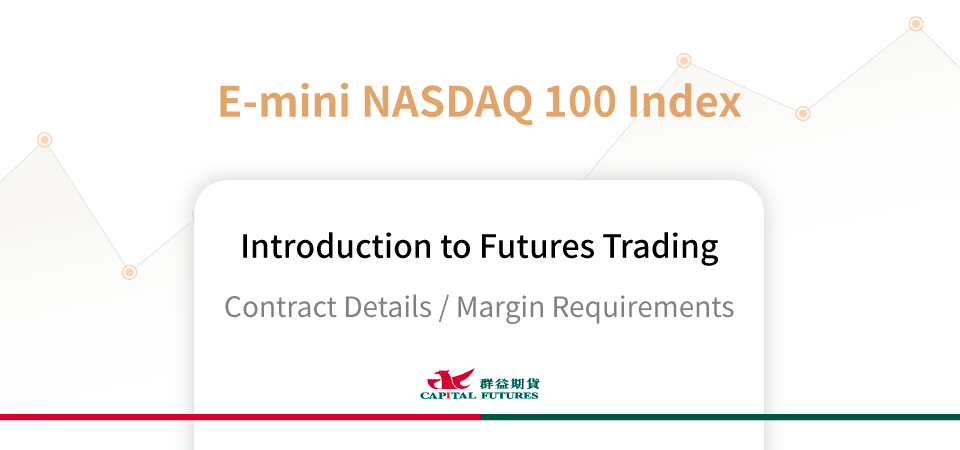E-mini NASDAQ 100 Index Futures Margin & Contract Specifications

What is the E-mini Nasdaq-100 Futures?
Understanding the Nasdaq-100
The Nasdaq-100 Index is a stock market index composed of the 100 largest domestic and international non-financial companies listed on the Nasdaq Exchange. It is weighted by market capitalization, with certain rules in place to balance out the influence of companies with very large market values. Notably, financial institutions are not included in this index.
Functions of E-mini Nasdaq-100 Futures
High liquidity: Provides deep market liquidity, allowing investors to gain exposure to the Nasdaq-100 Index in a simpler and more flexible way.
Efficient diversification: By managing a single futures contract, investors can achieve nearly the same risk exposure as managing 100 different stocks.
Extended trading hours: Nearly 24-hour trading sessions allow investors to react immediately to news and global events, even outside regular U.S. market hours.
Cross-margining: Enjoys margin offsets with other equity index futures.
Exchange
Chicago Mercantile Exchange (CME)
Key Factors Influencing E-mini Nasdaq-100 Futures
1. Nonfarm Payrolls (NFP)
Released monthly, this report reflects the health of the U.S. labor market and serves as a key reference for Federal Reserve policy.
2. Earnings Reports
Earnings announcements from publicly listed companies such as Apple, Nvidia, and Amazon can significantly affect market trends.
3. Consumer Price Index (CPI)
A measure of inflation. Rising inflation often leads to expectations of interest rate hikes, which may weigh on equity markets.
4. Federal Reserve Open Market Operations
The Fed’s buying and selling of government securities directly affect market liquidity and interest rate levels.
5. U.S. Unemployment Report
A critical indicator of economic strength that influences Fed policy and reflects overall economic performance.
6. Federal Open Market Committee (FOMC)
Interest rate decisions and statements released after each FOMC meeting are closely watched by market participants.
7. Industrial Production
Tracks changes in the volume of industrial goods produced each month.
8. Inventory Reports
Energy-related inventory data can influence energy prices, which in turn may indirectly affect the overall index.
9. Government Policies
U.S. government policies such as tax reforms, tech regulations, and trade agreements can reshape market expectations and investment strategies.
E-mini Nasdaq-100 Futures combine high liquidity and flexible trading hours, making them an essential tool for global investors to gain exposure to the technology sector and track U.S. equity indices. With just one contract, traders can effectively capture the performance of 100 leading technology and growth-oriented companies. Whether for short-term trading, hedging, or medium-to-long-term allocation, the E-mini Nasdaq-100 offers high flexibility and efficiency.
However, investors must also be mindful of market volatility and the impact of economic indicators on pricing. Careful risk management is essential to participate steadily in the global market.
E-mini NASDAQ 100 Index Margin
How much money is needed to trade futures? At the beginning, the required margin is the initial margin. While holding a position, the margin after deducting floating profits and losses must remain above the maintenance margin; otherwise, a margin call will be issued. For day-trading margin, only half of the margin is required, provided the position is closed before the market closes.
Foreign Futures
| Name | Code | Initial Margin | Approximate Cost in TWD | Maintenance Margin | Day Trading Margin |
|---|---|---|---|---|---|
| E-mini NASDAQ 100 Index | NQ | USD 33,307 | 1,013,865 | USD 30,279 | USD 16,654 |
| Micro E-mini NASDAQ 100 Index | MNQ | USD 3,331 | 101,396 | USD 3,028 | USD 1,666 |
E-mini NASDAQ 100 Index Contract Specifications
Here is a summary for traders of the contract specifications, exchange, trading hours, minimum price fluctuation, and available trading months for E-mini NASDAQ 100 IndexFutures, $Micro NASDAQ 100 IndexFutures.
| Name/Code | $ E-mini NASDAQ 100 IndexNQ |
|---|---|
| Exchange | Chicago Mercantile Exchange |
| Category | Futures |
| Local Trading Hours |
06:00-05:00 |
| Contract Specifications | Index×20 USD |
| Minimum Price Fluctuation | 0.25 Points =5 USD |
| Trading Months | 3,6,9,12 |
| Name/Code | $Micro NASDAQ 100 IndexMNQ |
|---|---|
| Exchange | Chicago Mercantile Exchange |
| Category | Futures |
| Local Trading Hours |
06:00-05:00 Last trading at 21:30 (cash settlement) Quarterly options (American style) expire at 21:30 on the third Friday. |
| Contract Specifications | Index×2 USD |
| Minimum Price Fluctuation | 0.25 Points =0.5 USD |
| Trading Months | 3,6,9,12 |
E-mini NASDAQ 100 IndexLast Trading Day
Futures
| Commodity | Jan | Feb | Mar | Apr | May | Jun | Jul | Aug | Sep | Oct | Nov | Dec | |
|---|---|---|---|---|---|---|---|---|---|---|---|---|---|
| E-mini NASDAQ 100 Index (NQ) | First Notice Day | - | - | 03/21 | - | - | 06/20 | - | - | 09/19 | - | - | 12/19 |
| Last Trading Day | - | - | 03/21 | - | - | 06/20 | - | - | 09/19 | - | - | 12/19 | |
| Micro E-mini NASDAQ 100 Index (MNQ) | First Notice Day | - | - | 03/21 | - | - | 06/20 | - | - | 09/19 | - | - | 12/19 |
| Last Trading Day | - | - | 03/21 | - | - | 06/20 | - | - | 09/19 | - | - | 12/19 | |




